
22 minute read
Change Agents

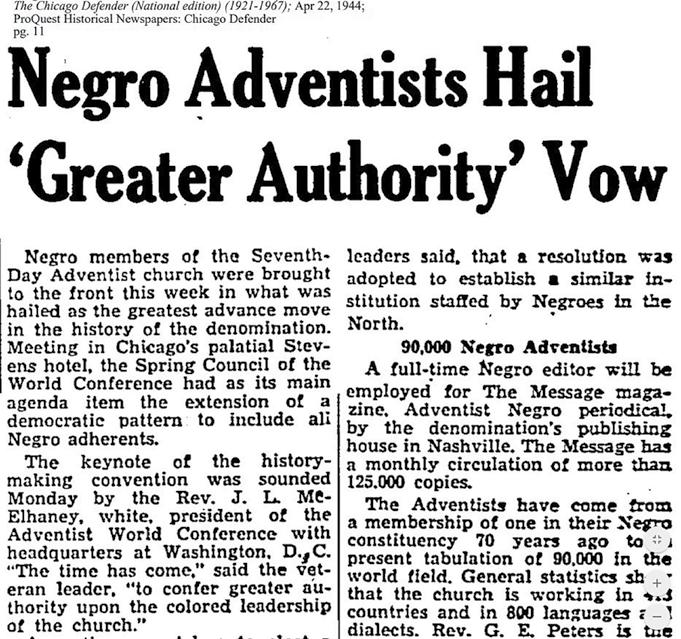
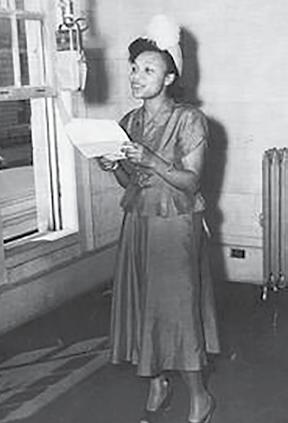

Awhite guest speaker from denominational headquarters was not an unusual occurrence for the Black congregation at Ephesus church in Washington, D.C. An unusual tension, however, hung over the atmosphere on Sabbath, October 16, 1943. Recent events had generated serious discontent, and W.G. Turner, the General Conference vice president for North America, had come to defuse it. He preached on 1 Peter 4:12: “Beloved, think it not strange concerning the fiery trial which is to try you, as though some strange thing happened unto you” (KJV).
As Turner, his discourse completed, turned to take his seat, James Montgomery immediately rose to his feet. His stature in the church as Sabbath School teacher and elder as well as music leader, and in the community as a civic-minded teacher and anti-poverty crusader, meant that his interruption of the usual order of things would be heard with respect.
He faced the congregation but spoke directly to the representative of the GC hierarchy: “Think it not strange? Yes, I think it very strange that there is an Adventist college nearby to which I cannot send my children. Yes, I think it is strange! A denominational cafeteria in which I cannot be served, and now this incident—I think it mighty strange!”
And now this incident…
The incident had taken place on September 22 when 65-year-old Lucille Byard, accompanied by her husband, James, arrived in Takoma Park after a wearying overnight train ride from New York City, anticipating treatment at the Washington Sanitarium. Mrs. Byard had become seriously ill several weeks before, and all the arrangements
Change Agents

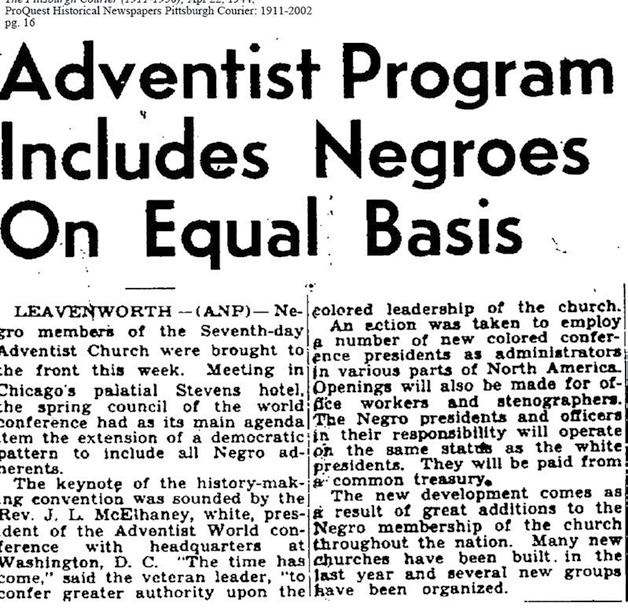

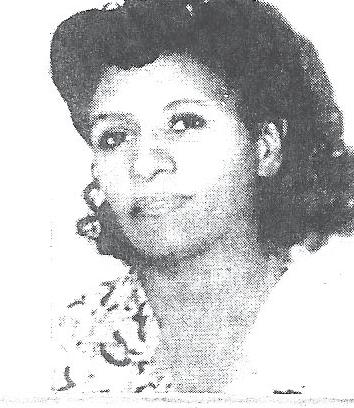
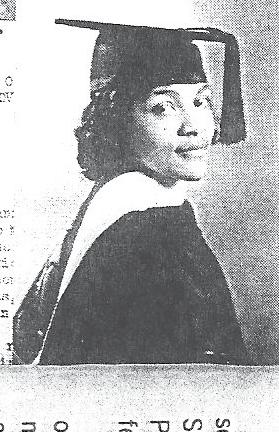
BY DOUGLAS MORGAN
for her admission as a patient had been finalized days in advance.
The Byards had turned to Jeter E. Cox, pastor of the Bethel church in Brooklyn, for help in arranging admission to the sanitarium. Even though the Washington Sanitarium generally did not welcome a Black clientele, it had occasionally admitted Black patients who were devout Seventhday Adventists. An exchange of letters that Cox initiated with sanitarium office personnel led to agreement that Mrs. Byard would be admitted for care on a “part-pay, part-charity” basis, with Bethel church agreeing to pay the amount billed. P.J. Baker, the sanitarium’s assistant business manager, sent Cox confirmation of the arrangement on September 17.
Apparently not even a hint of the possibility that Jeter E. Cox was a Black minister and Bethel was a Black Adventist church had registered with Mr. Baker. Meeting the Byards in person when they arrived on September 22 sent him directly into crisis mode. He immediately informed the sanitarium’s medical director, Dr. Robert A. Hare, that their new patient was a “colored person.”
Dr. Hare had a dilemma on his hands. By general policy, Washington Sanitarium did not accept Black patients, but now they had in fact admitted one, with all the particulars, including payment, duly arranged in advance and in writing. Two extant letters—one by Dr. Hare and the other by James Byard—shed light on what happened next but, due to their widely contrasting perspectives, also leave some question marks.
Dr. Hare’s account was sent to the General Conference officers on November 15, after the incident had flared into a full-blown denominational crisis, for the purpose of defending his institution and the actions he
Appendix 1 The Committee for the Advancement of World-wide Work Among Colored Seventh-day-Adventists George L. Daniels, Secretary First church choir director, elder, deacon, colporteur Appendix 1 The Committee for the Advancement of World-wide Work Among Colored Seventh-day-Adventists George L. Daniels, Secretary First church choir director, elder, deacon, colporteur Appendix 1 The Committee for the Advancement of World-wide Work Among Colored Seventh-day-Adventists George L. Daniels, Secretary First church choir director, elder, deacon, colporteur Appendix 1 The Committee for the Advancement of World-wide Work Among Colored Seventh-day-Adventists George L. Daniels, Secretary First church choir director, elder, deacon, colporteur Joseph T. Dodson, Chair Ephesus church elder, interim pastor (1936), business entrepreneur Alma J. Scott, Vice-Chair Founder, Southwest Community House; community activist; Valarie O. Justiss, Corresponding Secr. Social work administrator; activist; author; broadcaster; PhD, Ohio State (1948) Alan A. Anderson Pastor, then lay church leader; federal agency administrator Joseph T. Dodson, Chair Ephesus church elder, interim pastor (1936), business entrepreneur Alma J. Scott, Vice-Chair Founder, Southwest Community House; community activist; Valarie O. Justiss, Corresponding Secr. Social work administrator; activist; author; broadcaster; PhD, Ohio State (1948) Alan A. Anderson Pastor, then lay church leader; federal agency administrator Joseph T. Dodson, Chair Ephesus church elder, interim pastor (1936), business entrepreneur Alma J. Scott, Vice-Chair Founder, Southwest Community House; community activist; Valarie O. Justiss, Corresponding Secr. Social work administrator; activist; author; broadcaster; PhD, Ohio State (1948) Alan A. Anderson Pastor, then lay church leader; federal agency administrator Appendix 1 The Committee for the Advancement of World-wide Work Among Colored Seventh-day-Adventists George L. Daniels, Secretary First church choir director, elder, deacon, colporteur 1 The Committee for the Advancement of World-wide Work Among Colored Seventh-day-Adventists George L. Daniels, Secretary First church choir director, elder, deacon, colporteur Ephesus church elder, interim pastor (1936), business entrepreneur Alma J. Scott, Vice-Chair Founder, Southwest Community House; community activist; Corresponding Secr. Social work administrator; activist; author; broadcaster; PhD, Ohio State (1948) Alan A. Anderson Pastor, then lay church leader; federal agency administrator First church mainstay, commercial artist Joseph T. Dodson, Chair Ephesus church elder, interim pastor (1936), business entrepreneur Alma J. Scott, Vice-Chair Founder, Southwest Community House; community activist; Valarie O. Justiss, Corresponding Secr. Social work administrator; activist; author; broadcaster; PhD, Ohio State (1948) Alan A. Anderson Pastor, then lay church leader; federal agency administrator First church mainstay, commercial artist Ephesus church elder, interim pastor (1936), business entrepreneur Vice-Chair Founder, Southwest Community House; community activist; Corresponding Secr. Social work administrator; activist; author; broadcaster; PhD, Ohio State (1948) Pastor, then lay church leader; federal agency administrator commercial artist Ephesus church elder, interim pastor (1936), business entrepreneur Vice-Chair Founder, Southwest Community House; community activist; Corresponding Secr. Social work administrator; activist; author; broadcaster; PhD, Ohio State (1948) Pastor, then lay church leader; federal agency administrator commercial artist The Committee for the Advancement of World-wide Work Among Colored Seventh-day Adventists Joseph T. Dodson, Chair Ephesus church elder, interim pastor (1936), business entrepreneur Alma J. Scott, Vice-Chair Founder, Southwest Community House; community activist; Valarie O. Justiss, Corresponding Secr. Social work administrator; activist; author; broadcaster; PhD, Ohio State (1948) Alan A. Anderson Pastor, then lay church leader; federal agency administrator Laertes Gillis, Treasurer First church mainstay, commercial artist Lula B. Cox Educator, Sabbath School innovator, professor at Miner Teachers’ College Willie Anna Dodson Public school guidance counselor, principal; community activist Eva B. Dykes English professor; musician, choral director; PhD, Harvard (1921) James M. Montgomery educator; anti-poverty crusader; musician, elder, Sabbath School teacher Helen Ross Sugland educator; community and NAACP activist J. Estelle Barnett, Ohio Branch president. Founder, Joseph T. Dodson, Chair Ephesus church elder, interim pastor (1936), business entrepreneur Alma J. Scott, Vice-Chair Founder, Southwest Community House; community activist; Valarie O. Justiss, Corresponding Secr. Social work administrator; activist; author; broadcaster; PhD, Ohio State (1948) Alan A. Anderson Pastor, then lay church leader; federal agency administrator Laertes Gillis, Treasurer First church mainstay, commercial artist Lula B. Cox Educator, Sabbath School innovator, professor at Miner Teachers’ College Willie Anna Dodson Public school guidance counselor, principal; community activist Eva B. Dykes English professor; musician, choral director; PhD, Harvard (1921) James M. Montgomery educator; anti-poverty crusader; musician, elder, Sabbath School teacher Helen Ross Sugland educator; community and NAACP activist J. Estelle Barnett, Ohio Branch president. Founder, Joseph T. Dodson, Chair Ephesus church elder, interim pastor (1936), business entrepreneur Alma J. Scott, Vice-Chair Founder, Southwest Community House; community activist; Valarie O. Justiss, Corresponding Secr. Social work administrator; activist; author; broadcaster; PhD, Ohio State (1948) Alan A. Anderson Pastor, then lay church leader; federal agency administrator Laertes Gillis, Treasurer First church mainstay, commercial artist Lula B. Cox Educator, Sabbath School innovator, professor at Miner Teachers’ College Willie Anna Dodson Public school guidance counselor, principal; community activist Eva B. Dykes English professor; musician, choral director; PhD, Harvard (1921) James M. Montgomery educator; anti-poverty crusader; musician, elder, Sabbath School teacher Helen Ross Sugland educator; community and NAACP activist J. Estelle Barnett, Ohio Branch president. Founder, Joseph T. Dodson, Chair Ephesus church elder, interim pastor (1936), business entrepreneur Alma J. Scott, Vice-Chair Founder, Southwest Community House; community activist; Valarie O. Justiss, Corresponding Secr. Social work administrator; activist; author; broadcaster; PhD, Ohio State (1948) Alan A. Anderson Pastor, then lay church leader; federal agency administrator Laertes Gillis, Treasurer First church mainstay, commercial artist Lula B. Cox Educator, Sabbath School innovator, professor at Miner Teachers’ College Willie Anna Dodson Public school guidance counselor, principal; community activist Eva B. Dykes English professor; musician, choral director; PhD, Harvard (1921) James M. Montgomery educator; anti-poverty crusader; musician, elder, Sabbath School teacher Helen Ross Sugland educator; community and NAACP activist J. Estelle Barnett, Ohio Branch president. Founder, Lula B. Cox Educator, Sabbath School innovator, professor at Miner Teachers’ College Willie Anna Dodson Public school guidance counselor, principal; community activist Eva B. Dykes English professor; musician, choral director; PhD, Harvard (1921) James M. Montgomery educator; anti crusader; musician, elder, Sabbath School teacher J. Estelle Barnett, Ohio Branch president. Founder, Zanesville Civic League Community Center; Columbus-based community and lay church organizer J. Mark Cox Physician; medical director, Riverside Sanitarium Grace D. Kimbrough Philadelphia physician; community activist; Ebenezer church lay leader; Pine Forge donor Lula B. Cox Educator, Sabbath School innovator, professor at Miner Teachers’ College Willie Anna Dodson Public school guidance counselor, principal; community activist Eva B. Dykes English professor; musician, choral director; PhD, Harvard (1921) James M. Montgomery educator; anti crusader; musician, elder, Sabbath School teacher J. Estelle Barnett, Ohio Branch president. Founder, Zanesville Civic League Community Center; Columbus-based community and lay church organizer J. Mark Cox Physician; medical director, Riverside Sanitarium Grace D. Kimbrough Philadelphia physician; community activist; Ebenezer church lay leader; Pine Forge donor Lula B. Cox Educator, Sabbath School innovator, professor at Miner Teachers’ College Willie Anna Dodson Public school guidance counselor, principal; community activist Eva B. Dykes English professor; musician, choral director; PhD, Harvard (1921) James M. Montgomery educator; anti crusader; musician, elder, Sabbath School teacher J. Estelle Barnett, Ohio Branch president. Founder, Zanesville Civic League Community Center; Columbus-based community and lay church organizer J. Mark Cox Physician; medical director, Riverside Sanitarium Grace D. Kimbrough Philadelphia physician; community activist; Ebenezer church lay leader; Pine Forge donor Valarie O. Justiss, Corresponding Secr. Social work administrator; broadcaster; PhD, Ohio Alan A. Anderson Pastor, then lay church leader; federal agency administrator Laertes Gillis, Treasurer First church mainstay, commercial artist English professor; musician, choral director; PhD, Harvard (1921) James M. Montgomery educator; anti-poverty crusader; musician, elder, Sabbath School teacher Helen Ross Sugland educator; community and NAACP activist Valarie O. Justiss, Corresponding Secr. Social work administrator; broadcaster; PhD, Ohio Alan A. Anderson Pastor, then lay church leader; federal agency administrator Laertes Gillis, Treasurer First church mainstay, commercial artist musician, choral director; 1) James M. Montgomery educator; anti-poverty crusader; musician, elder, Sabbath School teacher Helen Ross Sugland educator; community and NAACP activist Lula B. Cox Educator, Sabbath School innovator, professor at Miner Teachers’ College Willie Anna Dodson Public school guidance counselor, principal; community activist Eva B. Dykes English professor; musician, choral director; PhD, Harvard (1921) James M. Montgomery educator; anti-poverty crusader; musician, elder, Sabbath School teacher Helen Ross Su educator; community and NAACP activist J. Estelle Barnett, Ohio Branch president. Founder, Zanesville Civic League Community Center; Columbus-based community and lay church organizer J. Mark Cox Physician; medical director, Riverside Sanitarium Grace D. Kimbrough Philadelphia physician; community activist; Ebenezer church lay leader; Pine Forge donor Addison V. Pinkney Baltimore educator, journalist, NAACP officer; Oakwood College president Lula B. Cox Educator, Sabbath School innovator, professor at Miner Teachers’ College Willie Anna Dodson Public school guidance counselor, principal; community activist Eva B. Dykes English professor; musician, choral director; PhD, Harvard (1921) James M. Montgomery educator; anti-poverty crusader; musician, elder, Sabbath School teacher Helen Ross Sugland educator; community and NAACP activist J. Estelle Barnett, Ohio Branch president. Founder, Zanesville Civic League Community Center; Columbus-based community and lay church organizer J. Mark Cox Physician; medical director, Riverside Sanitarium Grace D. Kimbrough Philadelphia physician; community activist; Ebenezer church lay leader; Pine Forge donor Addison V. Pinkney Baltimore educator, journalist, NAACP officer; Oakwood College president Lula B. Cox Educator, Sabbath School innovator, professor at Miner Teachers’ College Willie Anna Dodson Public school guidance counselor, principal; community activist Eva B. Dykes English professor; musician, choral director; PhD, Harvard (1921) James M. Montgomery educator; anti-poverty crusader; musician, elder, Sabbath School teacher Helen Ross Sugland educator; community and NAACP activist J. Estelle Barnett, Ohio Branch president. Founder, Zanesville Civic League Community Center; Columbus-based community and lay church organizer J. Mark Cox Physician; medical director, Riverside Sanitarium Grace D. Kimbrough Philadelphia physician; community activist; Ebenezer church lay leader; Pine Forge donor Addison V. Pinkney Baltimore educator, journalist, NAACP officer; Oakwood College president Lula B. Cox Educator, Sabbath School innovator, professor at Miner Teachers’ College Willie Anna Dodson Public school guidance counselor, principal; community activist Eva B. Dykes English professor; musician, choral director; PhD, Harvard (1921) James M. Montgomery educator; anti-poverty crusader; musician, elder, Sabbath School teacher Helen Ross Sugland educator; community and NAACP activist J. Estelle Barnett, Ohio Branch president. Founder, Zanesville Civic League Community Center; Columbus-based community and lay church organizer J. Mark Cox Physician; medical director, Riverside Sanitarium Grace D. Kimbrough Philadelphia physician; community activist; Ebenezer church lay leader; Pine Forge donor Addison V. Pinkney Baltimore educator, journalist, NAACP officer; Oakwood College president Joseph T. Dodson, Chair Ephesus church elder, interim pastor (1936), business entrepreneur Alma J. Scott, Vice-Chair Founder, Southwest Community House; community activist Valarie O. Justiss, Corresponding Secr. Social work administrator; activist; author; broadcaster; PhD, Ohio State (1948) Alan A. Anderson Pastor, then lay church leader; federal agency administrator Lula B. Cox Educator, Sabbath School innovator, professor at Miner Teachers’ College Willie Anna Dodson Public school guidance counselor, principal; community activist Eva B. Dykes English professor; musician, choral director; PhD, Harvard (1921) James M. Montgomery educator; anti-poverty crusader; musician, elder, Sabbath School teacher Helen Ross Sugland educator; community and NAACP activist J. Estelle Barnett, Ohio Branch president Founder, Zanesville Civic League Community Center; Columbus-based community and lay church organizer J. Mark Cox Physician; medical director, Riverside Sanitarium Grace D. Kimbrough Philadelphia physician; community activist; Ebenezer church lay leader; Pine Forge donor Addison V. Pinkney Baltimore educator, journalist, NAACP officer; Oakwood College president George L. Daniels, Secretary First church choir director, elder, deacon, colporteur Laertes Gillis, Treasurer First church mainstay, commercial artist Zanesville Civic League Zanesville Civic League Zanesville Civic League Zanesville Civic League had taken as its leader. Hare stated that he had Community Center; Community Center; Community Center; Community Center; Colored Department on September 25, makes Physician; medical director, Riverside instructed Mr. Baker to offer the Byards two alternatives. The first was a private room in the sanitarium, secluded from other patients, with meals delivered on a tray. Physicians would come by during “off hours.” Hare portrayed this as a reasonable, even no mention of an offer of a private room in the sanitarium. Byard simply recounted that “the attendant told me that he regretted to say this, but it was against the law of the State of Maryland to admit colored people into the Sanitarium” and recommended that his wife be taken to Columbus-based community and lay church organizer J. Mark Cox Physician; medical director, Riverside Sanitarium Grace D. Kimbrough Philadelphia physician; community activist; Ebenezer church lay leader; Pine Forge donor Addison V. Pinkney Baltimore educator, journalist, NAACP officer; Oakwood College president Columbus-based community and lay church organizer J. Mark Cox Physician; medical director, Riverside Sanitarium Grace D. Kimbrough Philadelphia physician; community activist; Ebenezer church lay leader; Pine Forge donor Addison V. Pinkney Baltimore educator, journalist, NAACP officer; Oakwood College president Columbus-based community and lay church organizer J. Mark Cox Physician; medical director, Riverside Sanitarium Grace D. Kimbrough Philadelphia physician; community activist; Ebenezer church lay leader; Pine Forge donor Addison V. Pinkney Baltimore educator, journalist, NAACP officer; Oakwood College president Columbus-based community and lay church organizer J. Mark Cox Physician; medical director, Riverside Sanitarium Grace D. Kimbrough Philadelphia physician; community activist; Ebenezer church lay leader; Pine Forge donor Addison V. Pinkney Baltimore educator, journalist, NAACP officer; Oakwood College president Grace D. Kimbrough Philadelphia physician; community activist; Ebenezer church lay leader; Pine Forge donor Addison V. Pinkney Baltimore educator, journalist, NAACP officer; Oakwood College president Grace D. Kimbrough Philadelphia physician; community activist; Ebenezer church lay leader; Pine Forge donor Addison V. Pinkney Baltimore educator, journalist, NAACP officer; Oakwood College president generous solution, given “the social sentiment that Freedmen’s Hospital. It dumbfounded Byard that
exists in Maryland.” He does not seem to have given much reflection to how it would feel to be quarantined on account of race, cut off from the social and spiritual interaction essential to the sanitarium’s program. He also failed to mention that the “private room” would be in the basement.
The other option would be for Mrs. Byard to go to Freedmen’s Hospital in Washington, D.C., for “the diagnostic work” that she desired. his wife’s need for “immediate attention” as a gravely ill woman of advanced years who had just endured a “tiresome and painful” train trip—not to mention that she was a sister in the faith for whom advance arrangements had been agreed upon—did not take precedence over all other considerations.
Bewildered and deeply aggrieved, the Byards reluctantly took a taxi to Freedmen’s Hospital,
James Byard’s poignant, briefer narrative, sent to G.E. Peters, director of the General Conference carrying a note from the sanitarium office explaining the referral. Lucy Byard remained in
the care of Freedmen’s Hospital until her death a month later on October 30.
As news of the appalling incident sizzled through telephone wires to concerned Adventists throughout the nation then, and as the story was repeated in the years that followed, embellishments and variations inevitably developed. Lucy Byard’s death became conflated with Washington Sanitarium’s refusal to admit her for treatment. Versions varied on the details of her death, but a larger historical truth united them. An act of blatant racial discrimination was closely juxtaposed with the death of the individual upon whom it was perpetrated. Conformity with racist customs caused an Adventist institution, which was defined by the sacred mission of nurturing life in its fullness, to send a member of its own family of faith away to die among strangers.
However, in our effort to understand just how the Byard incident became connected with decisive change in the Adventist church, it is significant that the refusal of treatment in itself sufficed to light a powder keg of accumulated grievance, frustration, and righteous indignation. That explosion in turn energized a movement for constructive change. Exacerbated by W.G. Turner’s homiletical miscalculation, it emboldened a circumspect James Montgomery to disrupt the October 16 Sabbath worship service with impassioned protest. The time for a racial reckoning had come in Adventism, but far more than the emotive force of Lucy Byard’s death was involved in making it a reality.
The time for change in Adventism came in 1943 because the Byard incident dramatized a longstanding pattern of abuse and failure in a way that exposed the status quo as intolerable. But the justified outrage it evoked did not automatically bring meaningful change in its wake. That required a courageous group of Black Adventist laity with the faith, skill, and resolve to organize a network of support, give voice to an agenda for change, and insist on being heard even though the church’s governance system offered them no viable channel for recognition or legitimacy and
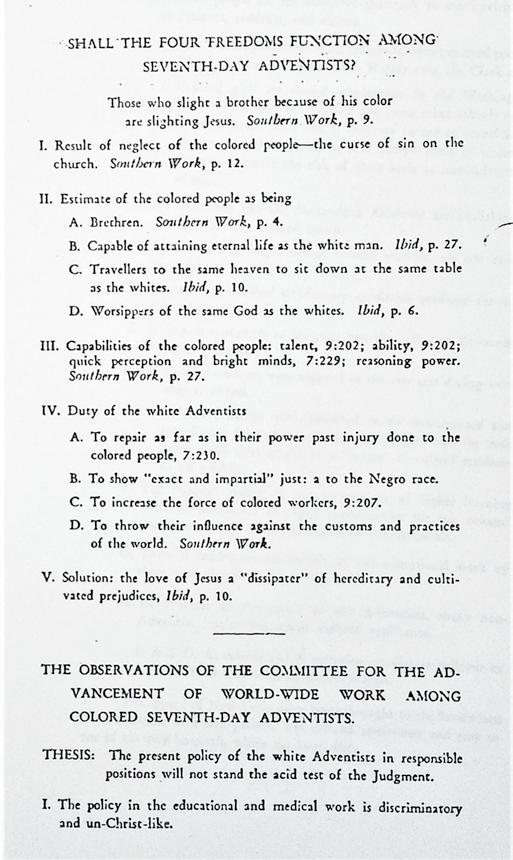
some church leaders seemed determined to keep it that way. But by 1943 the latent power of the Black Adventist laity had developed to the point that it could be drawn upon to mobilize righteous anger into a force for constructive change.

Birth of a movement
The fateful sermon on October 16 was the first public response by denominational leadership after becoming aware that discontent was reaching a crisis level. G.E. Peters apprised the General Conference officers about the crisis when they met on Sunday, October 3. The Byard incident, he reported, “had aroused considerable feeling” among Black Adventists, both in Washington and everywhere the news had spread.
As director of the North American Colored Department, Peters functioned as the lead representative and spokesperson for African American Adventists. This role placed on him the delicate, two-fold responsibility of both fostering the loyalty of Black believers to the denomination and advocating on their behalf to the denominational leaders.
Throughout the 50 years of their substantial presence in the denomination, Black believers had found it necessary on numerous occasions to point out to their white brethren how racial discrimination damaged the cause of God. But for the past five years, the concern had been rising to a more dangerous level than ever before.
The tenseness over race in American society in general just then underscored the urgency of Peters’ appeal in the minds of General Conference President J.L. McElhany and his colleagues. They had wrestled with the race question over and over through the years. But now, they recognized, it had reached a new level of urgency. Something broad and comprehensive needed to be done.
As he listened to Peters describe the situation, W.G. Turner formulated a plan of action. He believed he could quiet the storm brewing at Ephesus church over the Byard incident with a Sabbath sermon. Peters warned him against it. In this volatile situation, and especially with this congregation, anything that smacked of condescension or counsel of humble submission to injustice would only make things worse. He reminded Turner of the congregation’s large concentration of educators, outspoken community activists, medical professionals, and civil servants. But Turner forged ahead. After all, this problem fell within his realm of responsibility. It was incumbent upon him to show decisive leadership.
As a vice president of the General Conference, Turner had reached the highest echelons of an ecclesiastical bureaucracy that, by 1943, governed a rapidly growing, worldwide church with farreaching efficiency and hierarchical order. And that hierarchy was entirely the preserve of white, male, ordained clergy.
In preaching from 1 Peter 4 at Ephesus church on October 16, Turner joined a long tradition of using this and similar passages to reinforce intersecting hierarchies. When discontent threatened to boil over and disrupt the system, the first priority of leadership was to remind the
people of their place. Turner did not try to justify the treatment of Lucy Byard nor did he deny that his listeners had been long aggrieved by racial discrimination. This was the “fiery trial” that had come upon them. But their job as Christian laity was not to protest or attempt to take the solution into their own hands. Rather, their job was to bear it with Christ-like submission, remain loyal to God’s church, and trust Him for the ultimate solution. It would be the job of the General Conference leadership to work out any adjustments that might be needed to bring improvement.
The apostolic guidance in 1 Peter was given for believers navigating the conflicts posed by life amidst Greco-Roman society. Rather than try to defy the ordering structures of that society, the apostle urged believers to engage them with Christ’s nonretaliatory love, even in the face of abuses of power directed against them. But in the tradition of usage represented by Turner, the apostle’s exhortations were turned into counsels for uncomplaining submission to church hierarchy.
Further, the believers gathered at Ephesus church that day were not only lay people governed by a clerical hierarchy, they were among the 17,000 Black Adventists in America in a church governed by an all-white hierarchy. In that setting, nothing could have been better calculated to set off an explosion than to turn back two chapters and bring into the message one of slaveholding Christianity’s signature passages: “Servants, be subject to your masters with all fear” (1 Peter 2:18, KJV). But apparently Turner ventured there, because the report of James Montgomery’s rejoinder concludes with him declaring, “I am not prepared to hear you say, ‘Servants obey your masters,’ meaning the General Conference is our master.”
The time for change had come in the Seventh-day Adventist church. But change was not inevitable. The Byard incident might have stirred impassioned complaint, leading to a General Conference action for a study commission that would issue a report filled with action plans that went nowhere, with the entire episode then left to fester among the untreated racial wounds debilitating the Adventist body. That did not happen because a group of lay members from Washington, D.C.’s two Black Adventist churches—Ephesus and First church— principally powered by women, decided it was their calling to organize for change in a church governed by white clergymen—and not give up until it happened.
They met that very evening, after the Sabbath ended, to organize a movement for reform. Their goal was to unite the Black Adventist laity in confronting denominational leadership with the necessity of swift and decisive action toward realization of the racial justice and equality that the church claimed to espouse. The Committee for the Advancement of World-Wide Work Among Colored Seventh-day Adventists (the Committee, for short) was born.
Their story suggests that change is possible. Not necessarily ideal change, but worthwhile change, change against the odds, change worth the struggle.
Douglas Morgan teaches history at Washington Adventist University. This condensed version of the introduction is excerpted from Change Agents: The Lay Movement that Challenged the System and Turned Adventism Toward Racial Justice, available soon from Oak and Acorn.










